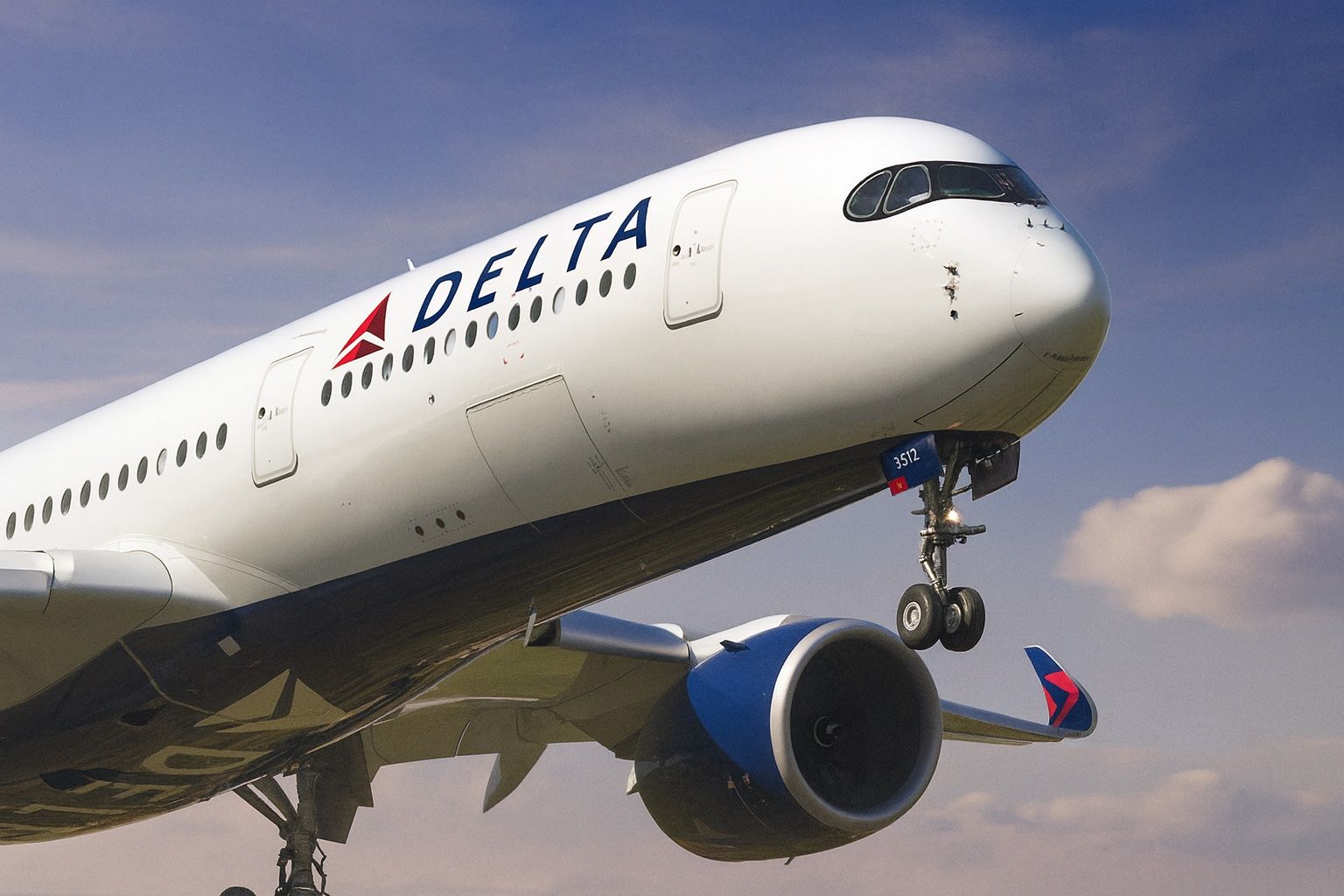- Stock Price Surge: Delta Air Lines (NYSE: DAL) stock jumped ~5–6% on Oct. 9, 2025, to around $60 after a strong earnings report and bullish guidance [1]. Over the past week, DAL traded in the mid-$50s and is now higher on the news, though it remains down ~5.6% year-to-date [2].
- Q3 Earnings Beat: Q3 2025 results topped expectations with adjusted revenue of $15.2 billion (+4% YoY) and EPS of $1.71, beating consensus by ~$0.19 [3]. Record revenue was driven by robust travel demand, especially in premium cabins and loyalty programs [4].
- Upgraded Forecast: Management raised guidance, forecasting Q4 2025 EPS of $1.60–$1.90 (midpoint $1.75 vs. $1.66 consensus) and about 2–4% revenue growth YoY [5] [6]. Full-year 2025 adjusted EPS is now projected around $6 (above the ~$5.77 expected) with free cash flow $3.5–4 billion, indicating strong momentum into 2026 [7].
- Travel Demand & Fares: Delta reported a rebound in corporate travel and sustained high leisure demand, enabling higher fares. Premium cabin revenue jumped ~9% YoY and now makes up ~43% of passenger revenue, while price-sensitive economy sales dipped 4% [8]. Capacity discipline across the industry (including a rival’s bankruptcy) has kept ticket prices elevated, supporting Delta’s unit revenues [9].
- Analyst Outlook: Wall Street is bullish on DAL – 20+ analysts rate it a “Buy”, with a consensus price target around $68 (implying ~20% upside) [10] [11]. The stock’s valuation looks modest at about 8–10× earnings (P/E ~8.3, P/S ~0.6), below historical averages [12] [13]. Delta’s dividend (resumed in 2023) yields ~1.3%, reflecting confidence in cash flow [14].
- Financials & Guidance: Trailing 12-month EPS has recovered post-pandemic, and revenue hit a record $16.7 billion in Q3 (GAAP) [15]. Operating margin was ~10% with cost controls keeping non-fuel costs flat [16]. Delta expects a 10.5–12% operating margin in Q4 [17], signaling solid profitability ahead.
- Industry Trends: Lower jet fuel prices have provided a tailwind – fuel averaged ~$2.30/gal in late 2025, ~7% cheaper than a year ago [18], aiding margins. However, volatile oil remains a risk. The broader airline sector is practicing capacity restraint; Delta notes that with Spirit Airlines’ exit and slower capacity growth industry-wide, pricing power has improved [19].
- Latest News & Events: In early October, Delta’s strong earnings and bullish outlook lifted not only its stock but also peers (UAL, AAL, etc. up 2–5%) [20]. The airline highlighted surging co-brand credit card revenue (American Express partnership contributed $2 billion in Q3) and plans to add more premium seats while trimming lower-fare capacity [21]. A U.S. government shutdown in October poses a short-term risk – over 13,000 flights were delayed in a week due to unpaid air traffic controllers [22], though Delta’s CEO said demand remains strong and the carrier is monitoring the situation [23].
- ESG and Innovation: Delta is pushing sustainability initiatives, aiming for net-zero emissions by 2050. In September, it achieved the first large-scale Sustainable Aviation Fuel (SAF) delivery at Portland (PDX) [24]. The airline is also partnering on next-gen aircraft (e.g. a hybrid-electric regional plane with Maeve Aerospace, targeting 40% fuel efficiency gains) [25]. These efforts landed Delta on Fast Company’s 2025 Most Innovative Companies list for sustainability.
- Ownership & Insider Activity: Institutional investors own about 81% of Delta’s shares [26], indicating strong interest from funds. Recent quarters saw some insider selling (e.g. executives sold ~73,000 shares in the last 3 months) [27], but no insider buying – a factor to watch. Overall, the company’s solid earnings and strategic moves appear to outweigh these sales in investors’ eyes.
Stock Performance and Recent Price Action
Delta’s stock has been on the move following its latest earnings. As of October 9, 2025, DAL trades around $60 per share after spiking about 5–6% on the Q3 report [28]. This marks a sharp rebound from the mid-$50s levels seen earlier in the week. Over the past week, the stock ranged roughly $56–$58 and is now up slightly week-over-week, bucking a broader market lull. Even after this rally, Delta’s share price remains ~5.6% lower year-to-date [29], underperforming the S&P 500, which makes the renewed momentum particularly noteworthy. The company’s market capitalization stands near $37–38 billion, making it one of the largest U.S. airlines [30]. Notably, Delta reinstated its dividend in late 2023; at the current price the stock yields about 1.3% (quarterly dividend of $0.19), providing income alongside potential capital appreciation [31].
From a technical analysis perspective, DAL’s recent move has it approaching the $60 level, which could act as near-term resistance. The 14-day RSI around 45–50 suggests neutral momentum – the stock is neither overbought nor oversold [32]. It is trading below its 52-week high (~$70) and above its lows, indicating room to climb if fundamentals support it. The broader trend in 2025 was choppy due to macroeconomic concerns, but the latest breakout on earnings news may signal a trend reversal. Volume spiked on the earnings beat, a positive sign that investor interest is returning. In summary, Delta’s stock is “taking off” after its earnings-fueled jump, and traders will be watching if it can sustain altitude above the $60 mark in coming sessions.
Q3 2025 Earnings Blowout
Delta Air Lines delivered strong third-quarter 2025 results, reinforcing confidence in its post-pandemic recovery. Revenue for Q3 (July–September) hit a record, with adjusted operating revenue of $15.2 billion, up 4.1% year-on-year [33]. This came in above analyst expectations (Delta beat the consensus revenue estimate by about $120 million) [34]. The top-line strength was broad-based, reflecting robust demand across premium leisure, business travel, and loyalty streams. On the bottom line, adjusted earnings per share (EPS) came in at $1.71, a 12.5% surprise over the $1.52 consensus [35]. This marks a sharp improvement from the $1.50 EPS of the prior year’s Q3, showcasing Delta’s earnings power in a normalized travel environment.
“We delivered September quarter results at the top end of our expectations on strong execution and improving fundamentals,” said CEO Ed Bastian [36]. GAAP net income was even higher, with GAAP EPS of $2.17 including one-time gains [37] [38], but analysts and management focus on adjusted results for a cleaner year-over-year comparison. Importantly, profitability soared despite rising costs in some areas – Delta achieved a 10.1% operating margin (GAAP) and 11.2% adjusted operating margin in Q3 [39], reflecting both higher revenues and disciplined cost control. Operating income was about $1.7 billion for the quarter [40].
Key revenue drivers stood out. Premium cabins and loyalty partnerships led growth: Delta’s premium fare revenue jumped ~9% versus Q3 2024, and loyalty program revenue (chiefly from credit card partnerships) rose 9% as well [41] [42]. In fact, remuneration from American Express reached $2 billion in Q3, up 12% YoY [43] [44]. This underscores Delta’s success in leveraging its SkyMiles loyalty program and co-branded credit card to drive high-margin income streams. These diversified revenues (premium, loyalty, cargo, maintenance) contributed over 60% of total revenue and grew at double-digit rates [45], providing resilience beyond just ticket sales [46].
Meanwhile, the Main Cabin (economy) segment saw some softness – main cabin revenue actually decreased ~4% year-on-year in Q3 [47] as the airline moderated cheap fare offerings and some price-sensitive travelers pulled back. However, this was more than offset by surging demand for higher-end offerings (Delta’s strategy to upsell customers into premium economy, business, and first class is paying off). The corporate travel rebound was a highlight: Delta reported that business travel bookings rose across all sectors, with corporate sales up 8% YoY in Q3 [48]. After a sluggish first half of 2025 for corporate travel, Delta saw an “inflection” in business demand late in the summer, contributing to the strong finish [49]. According to Delta President Glen Hauenstein, sales trends accelerated over the last six weeks of the quarter across all geographies and booking channels [50] – a very encouraging sign heading into the holidays.
On the cost side, Delta managed expenses well. Non-fuel unit costs were approximately flat year-over-year in Q3 [51] – impressive given inflationary pressures and higher labor costs under new union contracts. This kept year-to-date non-fuel cost per available seat mile (CASM) growth under 2%, in line with Delta’s low-single-digit guidance [52]. Fuel expense actually declined ~8% YoY [53], thanks to slightly lower jet fuel prices versus 2024 and Delta’s efficient operations. The average jet fuel price in Q3 2025 was around $2.30 per gallon, down about 7–9% from the prior year [54], which provided a welcome break in fuel cost inflation. Altogether, these factors drove a solid beat on the quarter’s financial results.
Bullish Guidance and Outlook
Delta’s management didn’t just rest on a strong Q3 – they issued an upbeat outlook for the rest of the year and into 2026, which further excited investors. For the December quarter (Q4 2025), Delta projects an operating margin of 10.5% to 12% and adjusted EPS between $1.60 and $1.90 [55] [56]. The midpoint of that EPS range (~$1.75) is above Wall Street’s prior estimates (~$1.66) [57], indicating Delta sees continued momentum. In fact, executives said that revenue in early Q4 is trending 2–4% higher than last year’s record holiday-quarter revenue [58]. They expect unit revenue (TRASM) to resume growth in Q4, helped by strong domestic demand and an improving trans-Atlantic market [59] [60].
For the full-year 2025, Delta now guides for about $6 in adjusted EPS [61] [62]. This would put earnings firmly in the upper half of the airline’s initial guidance range and well above 2024 levels, demonstrating a near full earnings recovery to pre-pandemic norms. If achieved, ~$6 EPS would also position Delta’s forward P/E near 9–10× at current share prices – a relatively low multiple given the growth outlook [63]. Free cash flow (FCF) for 2025 is forecast at $3.5–4.0 billion [64] [65], enabling Delta to continue deleveraging and rewarding shareholders (through the dividend and potential buybacks in the future). Indeed, Delta generated about $1.8 billion of operating cash in Q3 alone [66], and has been paying down debt (total debt was $14.9 billion at quarter-end, down significantly from pandemic highs) [67].
Delta’s CEO Ed Bastian struck a confident tone looking ahead, stating the airline is “well-positioned to deliver top-line growth as well as margin expansion next year.” [68] Executives highlighted that diversified high-margin revenues (premium cabins, loyalty, cargo, maintenance) now consistently contribute over half of total revenue, giving Delta a cushion even if the economic backdrop softens [69]. In 2026, Delta expects to build on its Centennial yearmomentum – 2025 marked the airline’s 100th anniversary – by expanding profitable niches like premium leisure travel and corporate services. Notably, Delta plans to increase premium seat offerings significantly in its fleet while scaling back capacity in the most price-sensitive economy segment [70]. This strategy should boost unit revenues and margins, essentially “selling fewer seats for more revenue each” – a formula investors tend to applaud.
That said, Delta’s rosy outlook excludes potential headwinds from the ongoing U.S. government shutdown (which began Oct. 1, 2025). The airline acknowledged that a prolonged federal shutdown could impact near-term demand and operations [71]. Already, air traffic control staffing issues due to unpaid workers have caused thousands of flight delays in early October [72]. (In one week of the shutdown, over 13,000 flights were delayed across the U.S. skies [73], and some travelers even canceled trips out of concern, according to Reuters.) Delta is monitoring the situation, though so far it has not needed to cut schedules. In the worst-case scenario of a lengthy shutdown, analysts warn of broader economic drag which could slow travel demand [74]. However, as of now, Wall Street has largely “shrugged off” the shutdown risks [75], and Delta itself expects any impact to be temporary. Aside from this wildcard, Delta’s guidance assumes a stable economic environment, continued strong travel appetite, and jet fuel prices remaining manageable.
In summary, the airline’s forward guidance and commentary portray cautious optimism. The company is essentially saying: demand is robust, our strategy is working, and we see a clear flight path to higher earnings barring any unforeseen turbulence. This upbeat message, combined with concrete guidance above expectations, was a catalyst for the stock’s rally and has many analysts reiterating their positive stance on DAL.
Travel Demand, Pricing Power, and Industry Dynamics
Delta’s performance and outlook cannot be fully understood without the context of the broader airline industry trendsin late 2025. A key theme is strong travel demand meeting constrained capacity. During Q3, Delta benefited from a unique industry setup: air travel demand (both leisure and corporate) remained high, but many airlines kept a lid on capacity growth. In fact, Delta noted a “sharp reduction” in available airline seats domestically, which has driven up ticket prices across the board [76]. Some contributing factors include the bankruptcy and downsizing of Spirit Airlines, a major discount carrier, and most airlines (mindful of profitability) moderating their expansion plans to avoid fare wars [77]. This supply discipline has given carriers like Delta unusual pricing power. Delta’s unit revenue (revenue per seat-mile) turned positive again in Q3 after a brief dip earlier in the year [78]. Executives confidently forecast unit revenue growth to stay positive in Q4 as well, thanks to the constrained supply and solid demand [79]. In short, fewer empty seats and less price discounting are a tailwind for the industry’s revenue environment.
On the demand side, trends are favorable across segments:
- Leisure Travel: Consumers continue to prioritize travel experiences. Delta’s international routes, especially Transatlantic flights, saw improvement. The summer season was strong, and early bookings for the winter holidays look healthy by Delta’s account. Notably, Delta is expanding its network – for example, launching a new Atlanta to Cape Town route and its first-ever service to Marrakech, Morocco in late October 2025, tapping into new leisure markets (these expansions signal confidence in sustained demand) [80]. Domestically, Delta hubs like Atlanta and Salt Lake City were bustling; domestic passenger revenue rose 5% YoY in Q3 [81].
- Business Travel: After lagging leisure recovery for two years, corporate travel is on the upswing. Delta reported gains in all corporate sectors, from consulting and finance to manufacturing. Surveys of corporate clients show ~90% of companies expect their travel volume to increase or stay steady in 2026, up from 85% a year ago [82]. This suggests business travel budgets are thawing. Delta’s diversified portfolio (including premium products and an improved travel experience) is capturing a good share of this returning business demand.
- Premium vs Economy: A clear trend is the “premiumization” of airline revenue. Delta’s strategy to invest in premium economy seats (Comfort+), lie-flat business suites, and other high-end offerings is paying off. Premium ticket sales now comprise 43% of Delta’s passenger revenues [83]. These customers are less sensitive to price and often bring in 2-3× the revenue of an economy passenger. In contrast, the most budget-sensitive flyers have been a weaker spot – as noted, main cabin revenue fell slightly, which Delta attributes to cutting back on unprofitable routes and fare classes [84]. Going forward, Delta is doubling down on premium, announcing plans to significantly increase premium seat supply (e.g., retrofitting aircraft with more premium seats) [85]. This could further boost average fares and yield.
Another critical factor is fuel prices and costs. Energy prices are a huge input for airlines; fortunately for Delta, jet fuel prices in 2025 have been relatively stable to slightly down year-on-year. According to industry data, the average cost per gallon of aviation fuel in August 2025 was about $2.30, down ~7% from August 2024 [86]. Similarly, September and early October saw jet fuel around the low-$2 per gallon range, well below the peaks seen in 2022. This moderation helped Delta’s Q3 fuel bill decline and offset wage increases. However, management remains vigilant – any spike in crude oil (e.g., due to geopolitical events) can quickly squeeze margins. Delta hedges less than some European airlines, but it has some protection via its Monroe refinery and fuel purchase agreements. As of now, fuel is an aid, not a hindrance, to earnings, but it’s a wildcard that bears watching.
On the regulatory and operational front, the U.S. government shutdown of October 2025 has introduced some uncertainty. With FAA air traffic controllers and TSA agents working unpaid, airlines faced sporadic delays. In the first week of the shutdown alone, over 3,000 flights were delayed in a single day (Oct. 7) due to controller shortages, with major hubs like O’Hare seeing average delays of 40+ minutes [87]. If the budget impasse continues, these issues could worsen – during the 2018-2019 shutdown, some airport security checkpoints closed and wait times ballooned [88] [89]. Delta’s CEO noted the airline is “monitoring the situation closely” but as of the earnings call had not cut any flights [90]. The travel industry estimates a $1 billion per week economic cost if the shutdown drags on [91], which would eventually hit airlines’ bookings. The silver lining is that markets believe a resolution will come before significant damage is done [92]. Indeed, airline stocks largely held steady through early October despite the Washington drama [93]. For now, this is a looming risk but not yet a material dent in demand.
Elsewhere in regulation, airlines are navigating proposed consumer-protection rules (e.g. refund requirements for delays, passenger compensation schemes) and ongoing discussions about pilot training and staffing. Delta, with one of the best operational track records, could fare better than ultra-low-cost rivals if new regulations impose higher service standards. Additionally, labor relations at Delta are relatively stable – pilots ratified a new contract in early 2023 with hefty raises, and Delta has been hiring to support growth. Unlike some competitors, Delta has avoided major labor strikes or disruptions recently, which is an operational advantage and helps it capture demand when others falter.
In summary, industry conditions in late 2025 favor well-managed airlines like Delta that can capitalize on strong demand and high fares while keeping costs in check. Delta’s focus on premium revenue streams, its operational excellence (often ranking at the top for on-time performance), and a measured approach to capacity growth are aligning well with what the market is rewarding. Barring any major external shock (fuel price spike, deep recession, or prolonged shutdown), Delta appears poised to cruise through the fourth quarter with solid performance.
Financial Health and Valuation
From an investment standpoint, Delta Air Lines presents a combination of improving fundamentals and relatively low valuation metrics. On the financial health side, Delta has made significant progress since the pandemic: revenues and earnings have rebounded strongly, and the airline is generating ample free cash flow. It is using that cash to pay down debt – total debt is now ~$15 billion [94], down from over $20 billion at the peak of COVID. The debt-to-equity ratio stands around 1.2, which, while not low, is quite manageable for an airline and continues to improve [95]. Delta retains an investment-grade credit rating and holds a sizable liquidity buffer (over $6 billion in cash as of mid-2025, per prior filings). One watchpoint: Delta’s Altman Z-Score (a bankruptcy risk metric) is about 1.3, which technically flags some distress risk [96]. This is common in the airline industry due to high debt and fixed costs, but there is no immediate solvency concern – it’s more a statistical artifact. In fact, Delta’s interest coverage and operating cash flow are quite solid now, indicating it can comfortably service its obligations.
Profitability metrics are robust. Delta’s operating margin for the last 12 months is ~9–10% [97] and net profit margin about 7% [98], which are among the best in the airline sector (Delta has often led the industry on margins). Return on invested capital (ROIC) is trending upward again as well, reflecting more efficient use of assets (high aircraft utilization and strong fare yields). Notably, Delta’s revenue has grown ~27% cumulatively over the past three years as it recovered from 2020, showing a strong trajectory [99].
Yet despite these positives, Delta’s stock valuation looks quite modest. The stock trades at a price-to-earnings (P/E) ratio around 8–9 (on a trailing basis) [100], which is low by both market standards and the company’s own historical levels. For reference, Delta’s pre-pandemic P/E often ranged in the low-teens. The forward P/E (using the ~$6 EPS guidance for 2025) is similarly around ~9–10, slightly below the industry average P/E (~10.9) for airlines [101]. Such a multiple suggests investors remain somewhat skeptical or have lingering concerns (perhaps memories of the volatile airline past or macro worries). However, a low P/E also indicates potential undervaluation, especially if Delta delivers on earnings growth. In addition, Delta’s price-to-sales (P/S) ratio is roughly 0.6 and price-to-book (P/B) around 2.1, both of which support the view of a modest valuation relative to other sectors [102]. For a company with Delta’s market position and profitability, these ratios appear conservative – possibly an opportunity if one expects the airline upcycle to continue.
Wall Street analysts certainly see value: the median 12-month price target is about $68 [103], ~15–20% above current levels. Some bullish analysts go even higher – targets in the $70s, and one high target at $90, implying substantial upside if all goes well [104]. According to MarketBeat, 20 out of 20 analysts covering DAL have it as a “Buy” or “Strong Buy” (no holds or sells) [105]. This unanimous positive consensus is somewhat rare, signaling that the expert community broadly expects Delta to outperform. The consensus price target around ~$67–68 [106] equates to roughly 10x forward earnings, still not aggressive, which suggests that if Delta exceeds forecasts or market sentiment on airlines improves, there could be further re-rating potential.
A few factors might be keeping the valuation muted: lingering economic risks (airlines are cyclical and sensitive to recessions), the aforementioned government shutdown risk, and perhaps concern about fuel or labor costs rising. Additionally, some investors are wary of airlines due to their historically boom-bust nature. Delta, however, has differentiated itself with more durable revenue streams (like its Amex credit card deal which brings steady cash even when people aren’t flying as much [107]). The company’s current P/E near 8.3 is “relatively low compared to historical highs, suggesting potential undervaluation,” as noted by GuruFocus [108]. Its PEG ratio(price/earnings-to-growth) is also attractive given that earnings are growing again at a double-digit clip.
From a shareholder return perspective, Delta’s management has indicated that once debt is normalized, they aim to resume share buybacks (suspended since 2020). The dividend, currently ~$0.19 per quarter, was reinstated only a year ago and could be gradually raised if earnings and cash flow keep increasing. These capital returns could enhance the stock’s appeal.
In financial summary, Delta Air Lines appears financially strong and undervalued by the market relative to its earnings power. The company’s solid balance sheet improvements, consistent profitability, and favorable industry positioning make a case that the low valuation multiples are not fully justified. If Delta continues executing well, there is room for the stock’s multiples to expand (closer to market average or historical norms), which, combined with earnings growth, underpins a bullish outlook on DAL.
Analyst Opinions and Market Sentiment
Expert commentary around Delta’s prospects has been largely positive, especially after the latest results. Analysts point out that Delta is firing on multiple cylinders – demand recovery, cost control, and strategic initiatives. Jefferies recently highlighted Delta’s improving revenue outlook and margin focus, noting that the Q3 unit revenue beat and raised guidance inspire confidence despite macro concerns [109]. Many analysts also emphasize Delta’s diversified revenue streams as a differentiator. As Reuters reported, “analysts say the company’s diversified revenue streams have made it better equipped than rivals to shield earnings” [110]. Unlike some competitors that rely mostly on ticket sales, Delta’s income from its maintenance division, cargo, and especially the SkyMiles credit card partnership provide a buffer in downturns. This was evident in early 2023 when economic jitters hit leisure travel – Delta still saw resilience thanks to those other streams.
Several sell-side firms have reiterated their bullish stance. For instance, UBS in July 2025 raised its price target from $62 to $72 while maintaining a Buy rating [111], citing Delta’s strong execution and capacity discipline. Morgan Stanley and Bank of America also rank Delta among top airline picks, applauding its premium revenue growth and balance sheet repair. On the earnings call, analysts probed Delta’s capacity plans and were pleased to hear the airline isn’t chasing market share at the expense of yields – a disciplined approach.
Market sentiment, as gauged by stock activity, improved after the earnings news. Before that, airline stocks had been under some pressure due to oil price volatility and recession fears. But Delta’s beat and upbeat outlook seemed to “turn the tide” for sentiment, at least in the near term. The fact that DAL stock popped ~5–6% on heavy trading volume indicates investor relief and optimism. It wasn’t just Delta – the positive read-across lifted stocks of United, American, JetBlue, and Alaska Air by a few percentage points as well [112], showing that Delta’s commentary boosted confidence in the sector broadly.
From a technical sentiment viewpoint, as mentioned, indicators are neutral to bullish. The stock’s RSI ~45-50 is neutral [113], but if the price continues upward, momentum traders might jump in. The next major resistance is around the $62-65 zone (where the stock traded in early 2025). A break above that on strong volume could trigger additional buying. Short interest in DAL is relatively low (a short float under 4% as of September) [114], implying not many are betting against the stock at this point.
One area of note is insider and institutional activity. Over the last quarter, some insiders (including Delta’s CEO and other executives) sold shares – roughly 73,000 shares were sold by insiders in the past 3 months [115]. These sales were at prices in the low $60s. While insider selling can sometimes signal caution, these trades could also be routine profit-taking or selling for personal diversification. There were no significant insider buys reported, but given the high institutional ownership, insiders hold a relatively small percentage of stock anyway. On the institutional side, 81% of Delta’s shares are held by institutions [116], including index funds and large investment firms. Top holders likely include Vanguard, BlackRock, and state retirement systems, which typically hold for the long term. Recent 13F filings (as of mid-2025) showed some hedge funds adding DAL to their portfolios, possibly anticipating the travel rebound. The high institutional ownership tends to stabilize the stock (fewer wild swings) but also means the stock moves with overall market flows and fund allocations to the sector.
Sentiment outlook: The combination of unanimous analyst buys, a strong earnings narrative, and relatively low valuation suggests that sentiment on DAL is skewing positive. The main caveats that analysts mention involve exogenous risks (e.g., “demand is strong now, but watch consumer spending if the economy slows” or “costs are in check, but fuel or labor could surprise”). Barring those, Delta is widely seen as a best-in-class operator set to outperform many peers. The company’s own confidence (resuming dividends, making strategic investments in fleet and technology) reinforces the sentiment that the worst is well behind it.
To sum up, expert commentary and market sentiment on Delta Air Lines are optimistic. The stock is considered undervalued by many, and the recent results have only strengthened the bull case. As long as Delta executes on its guidance and external conditions remain reasonably favorable, sentiment should remain in the bulls’ favor.
ESG and Sustainability Initiatives
In addition to financial performance, Delta Air Lines has been actively advancing its ESG (Environmental, Social, Governance) goals and sustainability initiatives, which increasingly factor into investor and public perceptions. The airline has committed to achieving net-zero carbon emissions by 2050 and has laid out interim steps to get there [117]. This is noteworthy as aviation is a hard-to-decarbonize sector; Delta’s approach is multifaceted:
- Sustainable Aviation Fuel (SAF): Delta is a leader in promoting SAF, which can cut lifecycle emissions by up to 80%. A recent milestone was reached in September 2025, when Delta, in partnership with Shell and the Port of Portland, completed the first-ever commercial-scale SAF uplift at Portland (PDX) [118] [119]. Over 400,000 gallons of blended SAF were delivered into the PDX fuel system, showcasing how industry collaboration can bring cleaner fuels to market. Delta has also facilitated SAF deliveries to hubs like Minneapolis and Detroit in prior initiatives [120]. Though SAF is currently costly and scarce (global production is still too low to fuel even a week of airline operations [121]), Delta’s efforts to “prove out” SAF logistics and advocate for government incentives (like the blender tax credits) are paving the way for broader adoption [122]. This positions Delta favorably for any future regulations on airline carbon emissions and appeals to environmentally conscious investors and customers.
- Fleet Modernization and Innovation: Delta is investing in a more fuel-efficient fleet and even exploring revolutionary aircraft designs. It has orders for new Airbus A321neo and A220 jets, which are significantly more fuel-efficient than the older planes they replace. Beyond that, Delta announced partnerships in 2025 to support innovative aircraft technologies – for example, a collaboration with start-up Maeve Aerospace to develop hybrid-electric regional aircraft that could be up to 40% more fuel efficient on short routes [123]. Delta also partnered with JetZero on a futuristic blended-wing body aircraft concept, aiming for a 50% improvement in fuel burn for mid-sized airliners [124] [125]. While such technologies are years away, Delta’s involvement demonstrates a proactive stance on sustainability and a vision of leading in aviation’s next era.
- Operational Efficiencies: Closer to the present, Delta has implemented numerous operational measures to save fuel – from single-engine taxi procedures to optimized flight routes using advanced flight planning software. In 2024, Delta achieved a 1% fuel burn savings (45 million gallons cut) through such initiatives [126], hitting an initial decarbonization milestone. It’s also experimenting with innovative ideas like “fello’fly” (mimicking bird formations to save energy) and applying sharkskin-inspired coatings to aircraft to reduce drag [127]. These may sound futuristic, but they reflect Delta’s culture of continuous improvement.
- Electrifying Ground Operations & Waste Reduction: Delta is working to electrify its ground service equipment (baggage tugs, belt loaders, etc.) at hubs to cut down on diesel usage [128]. It’s also removing single-use plastics and upping recycling on board and in lounges. The airline’s sustainability reports highlight progress in minimizing waste and improving water and energy use in its facilities [129].
These sustainability efforts have not gone unnoticed. Delta’s leadership on climate and innovation earned it a spot on Fast Company’s prestigious “Most Innovative Companies 2025” list specifically for sustainabilityinitiatives [130]. Additionally, Delta often scores well on ESG ratings among airlines, given its transparent reporting and concrete actions. Investors with ESG mandates may favor Delta for these reasons, seeing it as better prepared for a low-carbon future. It’s also a hedge against regulatory risk: as governments consider carbon taxes or emissions limits for aviation, Delta’s early adoption of SAF and efficient tech could give it a compliance edge.
From a social and governance perspective, Delta also has positive points. It consistently ranks high in customer satisfaction (J.D. Power surveys have Delta and its partner carriers scoring well). The company made headlines in 2023–2024 with significant raises for employees and sharing profits – a move that has kept labor relations largely positive. Delta’s board has an independent chairman and is noted for its diversity relative to peers. All these factors contribute to a generally good ESG profile.
In conclusion, Delta’s ESG journey is aligning with its business strategy: investing in sustainability is not only about corporate responsibility but also about long-term profitability in a world that demands cleaner transportation. These efforts, while not immediately boosting quarterly earnings, enhance Delta’s brand and could drive loyalty (eco-conscious travelers notice airlines’ green efforts). For a long-term investor, Delta’s commitment to innovation and sustainability adds an extra layer of confidence that the company is planning for the future of flight, not just the next quarter.
Conclusion
Delta Air Lines, Inc. emerges from the latest quarter as a strong leader in the airline industry, with its stock now gaining altitude thanks to impressive earnings and an encouraging outlook. The company is capitalizing on a potent mix of booming travel demand, higher fares, and internal initiatives to drive record revenues and solid profits. Its strategic focus on premium services and diversified revenue streams (like its credit card partnership) provides resilience in an uncertain economy. The recent Q3 2025 beat and raised guidance underscore management’s execution and optimism, which in turn has bolstered investor confidence in DAL stock.
At ~8–9 times earnings, Delta’s stock looks reasonably priced – perhaps even undervalued – relative to its earnings growth and industry standing [131]. Analysts overwhelmingly recommend buying, pointing to a price target in the upper-$60s [132], and noting that Delta’s fundamentals justify a higher share price. There are risks to monitor, of course: macroeconomic shifts, oil price swings, competitive capacity actions, and the resolution of the U.S. government shutdown saga will all influence Delta’s near-term fortunes. Additionally, while Delta’s financial health is sound, the airline industry can be volatile, and investors should be mindful of that cyclicality.
Nevertheless, Delta Air Lines enters the end of 2025 with significant tailwinds. Demand is strong, unit revenues are improving, and cost pressures like fuel have abated slightly. The company’s proactive stance on sustainable growth – from fleet upgrades to sustainability – also bodes well for its long-term viability and brand value. As we head into 2026, Delta expects to continue expanding margins and growing earnings, which, if achieved, could make the current stock price look quite attractive in hindsight.
For investors, the takeaway is that DAL is flying high fundamentally, and the market is beginning to take notice after a period of skepticism. The stock’s recent takeoff on earnings news suggests that positive catalysts are being rewarded. If Delta keeps up its trajectory of revenue and profit gains, there may be further upside in the stock. In the dynamic world of airlines, Delta stands out as a carrier that has not only recovered from past turbulence but is also charting a clear course for future success.
Sources:
- Reuters – Delta offers bullish outlook on higher fares, demand recovery [133] [134] [135] [136]
- PR Newswire – Delta Air Lines Announces September Quarter 2025 Financial Results [137] [138] [139]
- GuruFocus – Delta Air Lines Surpasses Q3 Earnings Expectations [140] [141]
- Nasdaq/Zacks – Pre-Market Earnings Report Oct 9, 2025 (P/E ratio data) [142]
- TradingView/Refinitiv – DAL shares rise on Q4 profit forecast [143] [144]
- BTS (U.S. DOT) – Airlines’ August 2025 Fuel Cost (fuel price YoY) [145]
- ts2.tech – Government Shutdown Shocker: Travel Impacts [146] [147]
- Delta News Hub – Delta partners on SAF at Portland [148]; Delta partners on hybrid electric aircraft [149]; Fast Company Award [150]
- MarketBeat – Analyst forecasts for DAL [151] [152]
References
1. www.tradingview.com, 2. www.tradingview.com, 3. www.gurufocus.com, 4. www.reuters.com, 5. www.reuters.com, 6. www.prnewswire.com, 7. www.gurufocus.com, 8. www.reuters.com, 9. www.reuters.com, 10. www.tradingview.com, 11. www.marketbeat.com, 12. www.gurufocus.com, 13. www.nasdaq.com, 14. www.google.com, 15. www.prnewswire.com, 16. www.prnewswire.com, 17. www.prnewswire.com, 18. www.bts.gov, 19. www.reuters.com, 20. www.reuters.com, 21. www.reuters.com, 22. www.reuters.com, 23. ts2.tech, 24. news.delta.com, 25. news.delta.com, 26. www.gurufocus.com, 27. www.gurufocus.com, 28. www.tradingview.com, 29. www.tradingview.com, 30. www.gurufocus.com, 31. www.google.com, 32. www.gurufocus.com, 33. www.prnewswire.com, 34. www.gurufocus.com, 35. www.tradingview.com, 36. www.prnewswire.com, 37. www.prnewswire.com, 38. www.prnewswire.com, 39. www.prnewswire.com, 40. www.prnewswire.com, 41. www.prnewswire.com, 42. www.prnewswire.com, 43. www.prnewswire.com, 44. www.reuters.com, 45. www.prnewswire.com, 46. www.reuters.com, 47. www.reuters.com, 48. www.prnewswire.com, 49. www.prnewswire.com, 50. www.prnewswire.com, 51. www.prnewswire.com, 52. www.prnewswire.com, 53. www.prnewswire.com, 54. www.bts.gov, 55. www.prnewswire.com, 56. www.prnewswire.com, 57. www.tradingview.com, 58. www.prnewswire.com, 59. www.prnewswire.com, 60. www.prnewswire.com, 61. www.prnewswire.com, 62. www.gurufocus.com, 63. www.nasdaq.com, 64. www.prnewswire.com, 65. www.gurufocus.com, 66. www.prnewswire.com, 67. www.prnewswire.com, 68. www.reuters.com, 69. www.reuters.com, 70. www.reuters.com, 71. www.reuters.com, 72. www.reuters.com, 73. www.reuters.com, 74. ts2.tech, 75. ts2.tech, 76. www.reuters.com, 77. www.reuters.com, 78. www.prnewswire.com, 79. www.prnewswire.com, 80. news.delta.com, 81. www.prnewswire.com, 82. www.prnewswire.com, 83. www.reuters.com, 84. www.reuters.com, 85. www.reuters.com, 86. www.bts.gov, 87. ts2.tech, 88. ts2.tech, 89. ts2.tech, 90. ts2.tech, 91. ts2.tech, 92. ts2.tech, 93. ts2.tech, 94. www.prnewswire.com, 95. www.gurufocus.com, 96. www.gurufocus.com, 97. www.gurufocus.com, 98. www.gurufocus.com, 99. www.gurufocus.com, 100. www.gurufocus.com, 101. www.nasdaq.com, 102. www.gurufocus.com, 103. www.tradingview.com, 104. www.marketbeat.com, 105. www.marketbeat.com, 106. www.marketbeat.com, 107. www.reuters.com, 108. www.gurufocus.com, 109. stocktwits.com, 110. www.reuters.com, 111. www.sahmcapital.com, 112. www.reuters.com, 113. www.gurufocus.com, 114. finance.yahoo.com, 115. www.gurufocus.com, 116. www.gurufocus.com, 117. www.delta.com, 118. news.delta.com, 119. news.delta.com, 120. news.delta.com, 121. news.delta.com, 122. news.delta.com, 123. news.delta.com, 124. news.delta.com, 125. news.delta.com, 126. news.delta.com, 127. news.delta.com, 128. www.delta.com, 129. www.delta.com, 130. news.delta.com, 131. www.gurufocus.com, 132. www.tradingview.com, 133. www.reuters.com, 134. www.reuters.com, 135. www.reuters.com, 136. www.reuters.com, 137. www.prnewswire.com, 138. www.prnewswire.com, 139. www.prnewswire.com, 140. www.gurufocus.com, 141. www.gurufocus.com, 142. www.nasdaq.com, 143. www.tradingview.com, 144. www.tradingview.com, 145. www.bts.gov, 146. ts2.tech, 147. ts2.tech, 148. news.delta.com, 149. news.delta.com, 150. news.delta.com, 151. www.marketbeat.com, 152. www.marketbeat.com








